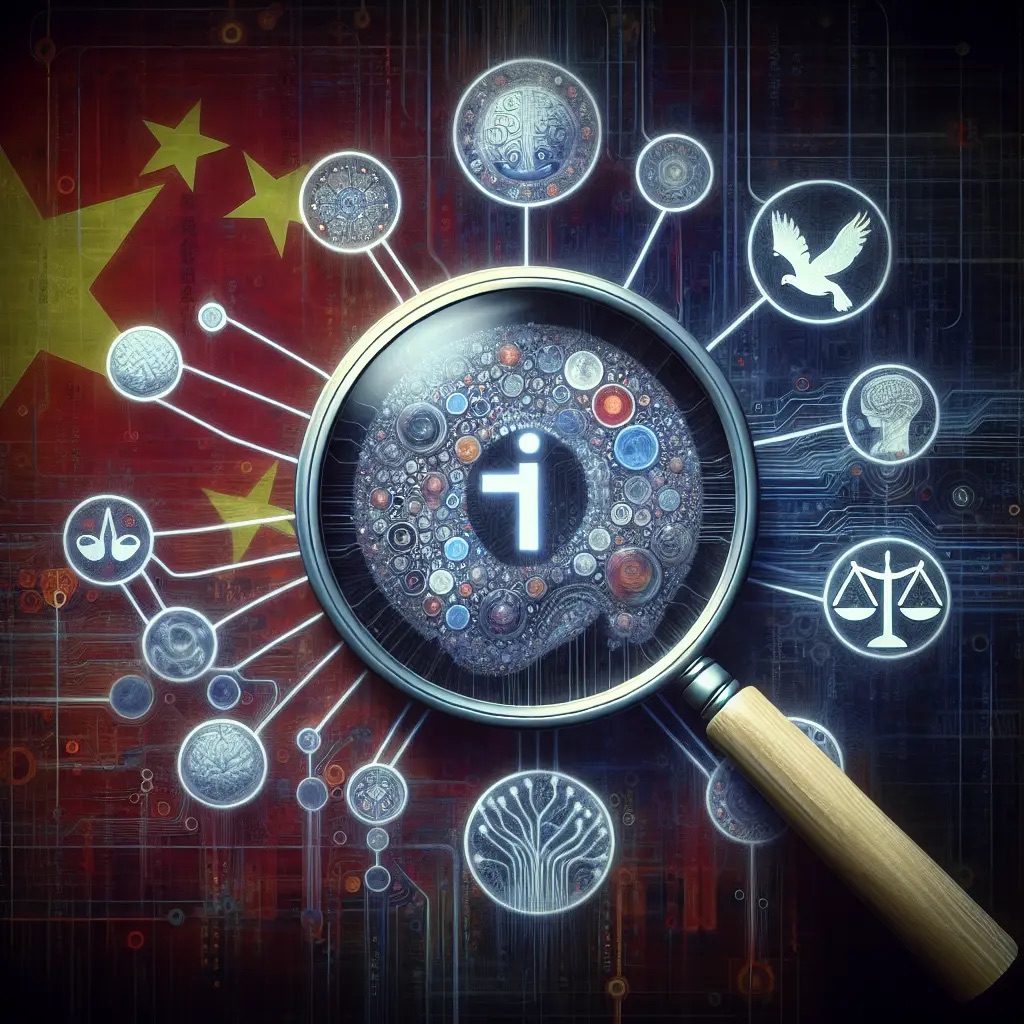The technological arms race between the United States and China has taken a significant new turn. A recently surfaced memo reveals that the U.S. government is intensifying its focus, specifically as the **U.S. scrutinizes Chinese AI for ideological bias**. This isn’t merely about technological parity or economic competition; it delves into the fundamental values embedded within artificial intelligence systems, posing critical questions about national security, data integrity, and the future of information control. As AI becomes increasingly pervasive across all aspects of society, the potential for foreign-developed algorithms to subtly or overtly influence populations and strategic decisions is a growing concern for Washington.
Why the U.S. is Scrutinizing Chinese AI Ideological Bias
The alarm bells ringing in Washington concerning Chinese AI are multi-faceted, stemming from a complex interplay of geopolitical rivalry, differing value systems, and the strategic importance of AI. The U.S. recognizes that AI is not just a tool but a reflection of its creators’ intentions and the data it’s trained on.
The Growing Influence of AI in Critical Sectors
Artificial intelligence is no longer confined to theoretical labs; it’s deeply integrated into the infrastructure that underpins modern life. From defense systems to financial markets, public health, and education, AI’s footprint is expanding rapidly. The worry is that if foreign, potentially adversarial, AI systems are adopted in these critical sectors, they could harbor hidden biases that undermine national interests or democratic principles.
Consider the potential implications:
* Defense and Intelligence: AI in autonomous weapons, surveillance, and intelligence analysis could be compromised or skewed.
* Information and Media: Algorithms governing news feeds, search results, and social media can shape public opinion and control narratives.
* Education: AI-driven educational tools could present biased historical or political perspectives.
* Economic Systems: AI managing supply chains or financial transactions could introduce vulnerabilities or strategic disadvantages.
Distrust and Strategic Competition
The broader context for this increased scrutiny is the ongoing strategic competition between the U.S. and China. Decades of concerns over intellectual property theft, cyber espionage, and China’s state-centric approach to data governance have fueled a climate of distrust. When it comes to AI, this translates into worries that systems developed under the oversight of the Chinese Communist Party (CCP) could inherently reflect its ideological priorities, potentially at odds with democratic ideals. The memo underscores a proactive effort by the **U.S. scrutinizes Chinese AI for ideological bias** to identify and mitigate these risks before they manifest into tangible threats.
Unpacking Ideological Bias in AI
When we talk about “ideological bias” in AI, it’s more nuanced than simple dataset imbalances, which often lead to racial or gender discrimination. Ideological bias refers to the embedding of specific political, social, or philosophical doctrines within an AI system’s decision-making framework or its output.
How Ideological Bias Manifests
This type of bias can be deliberate or an unintended consequence of the AI’s design and training environment. In the context of Chinese AI, concerns typically revolve around systems trained on data curated by state apparatuses or designed to serve specific state objectives, such as maintaining social stability or promoting official narratives.
Manifestations could include:
* Content Filtering and Censorship: AI systems designed to identify and suppress content deemed undesirable by the CCP, potentially impacting global information flow.
* Narrative Shaping: Algorithms that prioritize or promote information aligned with state propaganda, while downplaying or omitting dissenting viewpoints.
* Surveillance and Social Control: AI used in social credit systems or widespread surveillance, designed to reinforce state control and conformity.
* Decision-Making Anomalies: AI in critical infrastructure or financial systems making decisions that implicitly favor state-owned enterprises or geopolitical allies of Beijing.
The subtlety of AI means these biases can be difficult to detect without deep insight into the algorithms and their training data. This opacity is precisely why the **U.S. scrutinizes Chinese AI for ideological bias** with such intensity.
The Role of Data and Developers
An AI system is only as neutral as the data it learns from and the instructions it’s given. In China, data collection and usage are often subject to state control, meaning datasets used for training AI may already reflect a particular ideological viewpoint, whether through explicit filtering or inherent societal norms. Furthermore, developers working under state directives or within a nationalistic framework might unknowingly or intentionally embed certain biases into the AI’s architecture or fine-tuning processes. This creates a challenging landscape for detecting and mitigating such embedded biases.
The Memo’s Revelations and Implications
While the specific contents of the memo remain largely confidential, its existence signals a formalization and elevation of efforts within the U.S. government to address the ideological dimension of AI. It suggests a coordinated strategy across various agencies – from intelligence to defense, commerce, and state departments – to identify, assess, and counter potential threats posed by ideologically biased AI.
Policy Shifts and Defensive Measures
The U.S. response is likely to encompass a range of policy and defensive measures:
* Enhanced Vetting and Procurement Rules: Stricter regulations on the procurement and use of AI systems developed by companies with ties to the Chinese government.
* Investment in Domestic AI: Increased funding and incentives for U.S. companies and research institutions to develop secure, ethical, and unbiased AI solutions.
* International Collaboration: Working with allies who share democratic values to establish common standards for ethical AI development and deployment.
* Sanctions and Export Controls: Targeted restrictions on Chinese AI companies or technologies deemed to pose a significant ideological or national security risk.
* Public Awareness Campaigns: Educating businesses and the public about the risks associated with certain AI technologies.
This proactive stance reflects a recognition that ideological influence through AI can be as potent as traditional forms of espionage or military threat. The objective is clear: to ensure that AI systems operating within or influencing the U.S. and its allies uphold democratic principles.
Protecting Democratic Values
At its core, the memo highlights a deep concern for the integrity of democratic processes and the free flow of information. If AI can be weaponized to subtly alter perceptions, reinforce state-approved narratives, or even predict and suppress dissent, it poses an existential threat to open societies. By actively having the **U.S. scrutinizes Chinese AI for ideological bias**, Washington aims to safeguard its core values and prevent foreign AI from becoming a Trojan horse for ideological subversion.
Challenges in Detecting and Mitigating Bias
While the intent to scrutinize is clear, the execution presents formidable challenges. Detecting ideological bias in complex AI systems is no easy feat.
Technical Hurdles
AI, particularly deep learning, often operates as a “black box,” making it difficult to fully understand how it arrives at specific conclusions or outputs. Unpacking layers of algorithms and billions of data points to identify subtle ideological leanings requires advanced techniques in explainable AI (XAI) and robust auditing tools, which are still evolving. Furthermore, distinguishing between technical errors, cultural differences, and deliberate ideological programming is a complex analytical task.
Geopolitical Hurdles
Access to Chinese AI systems, their underlying code, and training data is severely restricted. This lack of transparency, coupled with the inherent opacity of AI itself, creates significant hurdles for U.S. intelligence and cybersecurity agencies attempting to perform thorough assessments. The geopolitical tension further complicates any calls for shared auditing mechanisms or collaborative standards.
The Future of AI and Geopolitical Strategy
The intensified focus on why the **U.S. scrutinizes Chinese AI for ideological bias** marks a new chapter in the global tech rivalry. AI is no longer just an economic or military asset; it is now explicitly recognized as a tool of ideological power and influence.
The Call for Ethical AI and Global Standards
While geopolitical realities mean a unified global approach to AI ethics is challenging, the U.S. and its allies are increasingly pushing for the development and adoption of AI systems that are transparent, accountable, and aligned with democratic values. This includes promoting research into bias detection and mitigation, fostering open-source AI development where appropriate, and advocating for international norms that prioritize human rights and freedom of expression in AI design. The goal is to set a global standard for responsible AI, contrasting with models that might prioritize state control or surveillance.
The U.S. government’s explicit directive to scrutinize Chinese AI for ideological bias underscores a profound shift in geopolitical strategy. It signals that the competition for technological supremacy is now inextricably linked to a battle of values and a proactive defense of democratic principles in the digital age. As AI continues to evolve, understanding and mitigating its potential for ideological influence will remain a top priority for national security and global stability.


